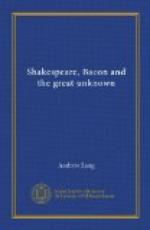To me the evidence of the style as to the date of both monument and bust speaks so loudly for their accepted date (1616-23) and against the Georgian date of 1748, that I need no other evidence; nor do I suppose that any one familiar with the monumental style of 1590-1620 can be of a different opinion. In the same way I do not expect any artist or engraver to take the engraving of the monument in Rowe’s Shakespeare (1709), and that by Grignion so late as 1786, for anything but copies of the design in Dugdale, with modifications made a plaisir. In Pope’s edition (1725) Vertue gives the monument with some approach to accuracy, but for the bald plump face of the bust presents a top-heavy and sculpturally impossible face borrowed from “the Chandos portrait,” which, in my opinion, is of no more authority than any other portrait of Shakespeare. None of them, I conceive, was painted from the life.
The Baconians show a wistful longing to suppose the original bust, copied in Dugdale, to have been meant for Bacon; but we need not waste words over this speculation. Mr. Greenwood writes that “if I should be told that Dugdale’s effigy represented an elderly farmer deploring an exceptionally bad harvest, ’I should not feel it to be strange!’ Neither should I feel it at all strange if I were told that it was the presentment of a philosopher and Lord Chancellor, who had fallen from high estate and recognised that all things are but vanity.”
“I should not feel it to be strange” if a Baconian told me that the effigy of a living ex-Chancellor were placed in the monument of the dead Will Shakspere, and if, on asking why the alteration was made, I were asked in reply, in Mr. Greenwood’s words, “Was Dugdale’s bust thought to bear too much resemblance to one who was not Shakspere of Stratford? Or was it thought that the presence of a woolsack” (the cushion) “might be taken as indicating that Shakspere of Stratford was indebted for support to a certain Lord Chancellor?” {186a} Such, indeed, are the things that Baconians might readily say: do say, I believe.
Dugdale’s engraving reproduces the first words of a Latin inscription, still on the monument:
Judicio Pylium, genio Socratem, arte Maronem
Terra tegit, populus maeret, Olympus
habet:




